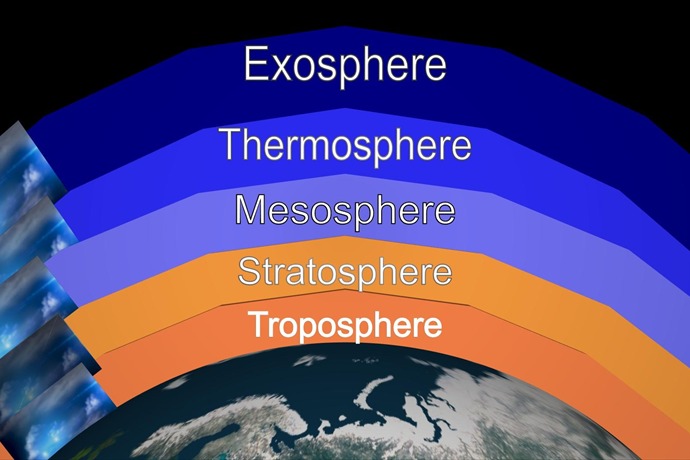
Atmosphere:
- The thick layer of air that surrounds the earth’s crust is called the
- This canopy of air covers the lithosphere (the crust and the uppermost mantle) and hydrosphere (all the water on the earth’s surface) of this earth.
- It consists of different types of gases like oxygen, nitrogen, carbon dioxide, neon, argon along with water vapor and dust particles.
- As the altitude increases, the layer of atmosphere becomes thinner, and the temperature also varies at different angles.
- On the basis of varying density, altitude and temperature, the atmosphere is divided into five distinct layers.
- Troposphere
- Stratosphere
- Mesosphere
- Thermosphere
- Exosphere
- The distinguished transitory layers called pauses are present between these individual layers.
- Troposphere:
- It is the lowermost layer of the atmosphere extending up to 16km from the surface of the earth.
- This layer lies at about 8-10 km at the poles and 16 km at the equator.
- About 95% of the atmosphere lies in this layer.
- Large amount of heavy gases like nitrogen, oxygen, carbon dioxide, inert gases, water vapor etc. are present.
- Cloud formation, wind, lightning, rain, hail stone fog formation etc. take place in this layer.
- Troposphere is important for the meteorologists as they forecast weather by studying this layer.
- The temperature falls by 6.5oC for every 1 km rise in altitude.
- As the temperature varies with height, this layer is also called a variable layer.
- The uppermost part of this layer is called the tropopause.
- Stratosphere:
- It is the second layer over troposphere extending from 16 to 50 km above the surface of the earth.
- Ozone, nitrogen and oxygen are the main gases present in this layer.
- Ozone layer lies on the upper part of this layer, hence also called the ozonosphere.
- At about 20-30 km from the surface, ozone layer is continuously formed and depleted because of UV radiation from the sun.
- 99% of UV radiation from the sun is absorbed by ozone layer and hence protects plants and animals from its harmful effects.
- The temperature starts increasing (from -560C to -20C) with the increase in the altitude because of absorption of solar radiation by ozone layer.
- There is less water vapor and thin clouds and hence all the jet planes fly in this layer to avoid the bumpy air pockets of troposphere.
- The uppermost boundary of this layer is called the stratopause, which separates the stratosphere from the mesosphere.
- Mesosphere:
- It is the third layer and extends from 50 to 80 km above the earth’s surface.
- The temperature decreases with height and reaches up to -1090 C.
- The streaks of hot gases released from meteors can be seen in this layer.
- The uppermost boundary of this layer is called the mesopause which separates the mesosphere from the thermosphere.
- Thermosphere:
- It is the fourth layer and starts from the mesopause.
- This layer extends from 80 to 720 km above the earth’s surface and occupies about 0.01% of the total atmosphere.
- The temperature increases with height due to solar radiation.
- The density of air is very low and the gases present are very low.
- The lower region contains nitrogen and oxygen molecules, whereas the upper region consists of hydrogen and helium.
- The gaseous molecules (nitrogen and oxygen) undergo ionization and give ions due to the effect of UV radiation of the sun, hence this region is also called the ionosphere.
- Radio waves transmitted from the earth are reflected back to the earth from this layer and thus helps in communication.
- The uppermost region of this layer is called thermopause.
- Exosphere:
- It is the outermost layer of the atmosphere which extends beyond the thermosphere.
- It extends from 720 km and gradually merges with the outer space.
- The temperature of this layer is very high.
- The density of air is very low, but the wind blows at high speed.
- This layer is very far from the earth’s surface, so there is no effect of gravity.
- It is also called the fringe region as it forms the outermost edge of the atmosphere.
